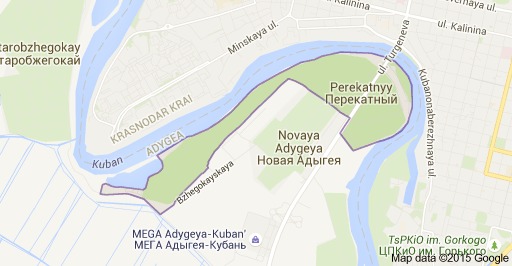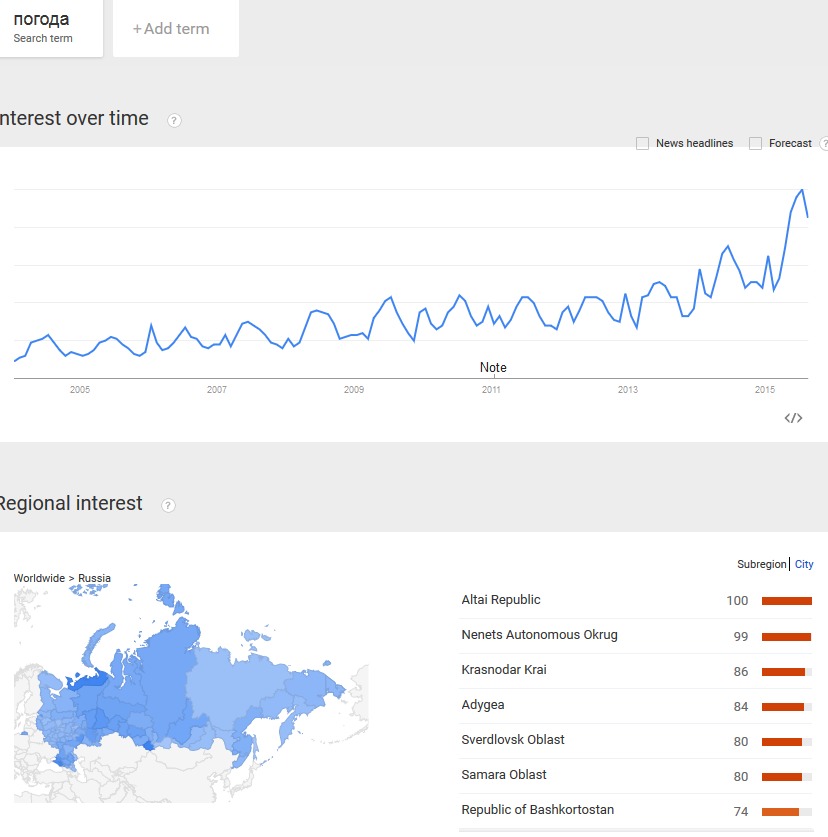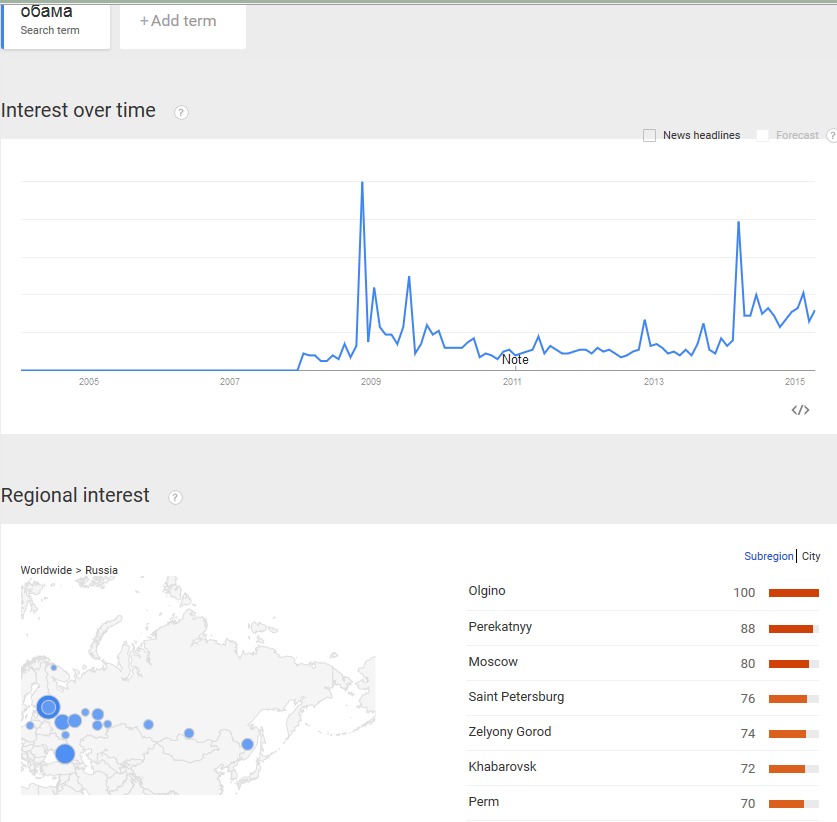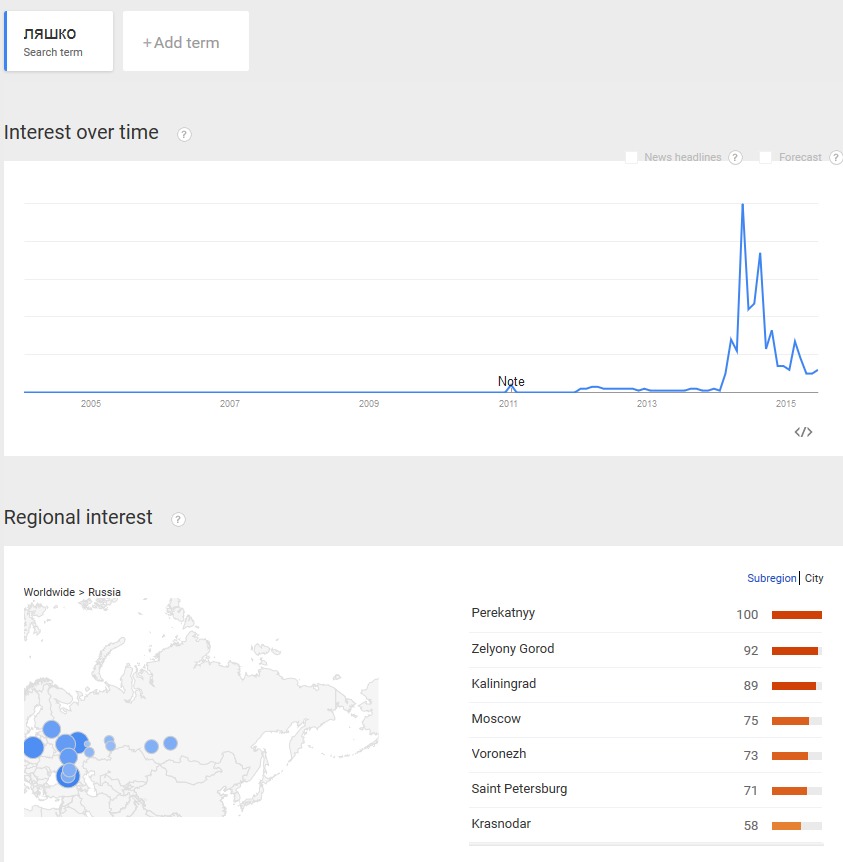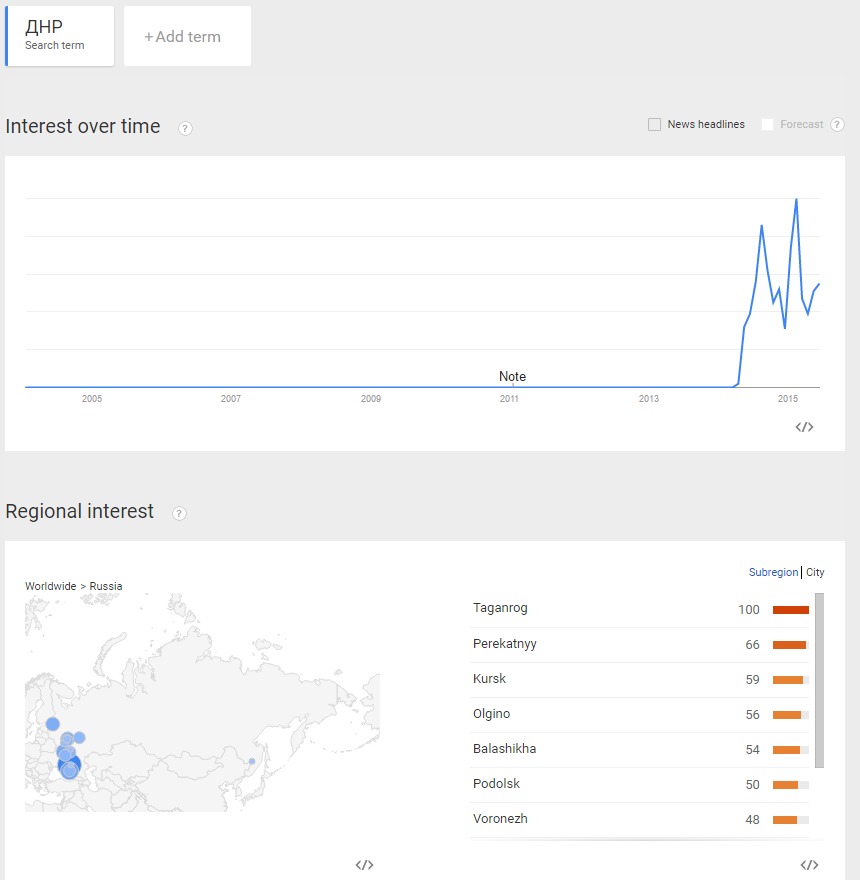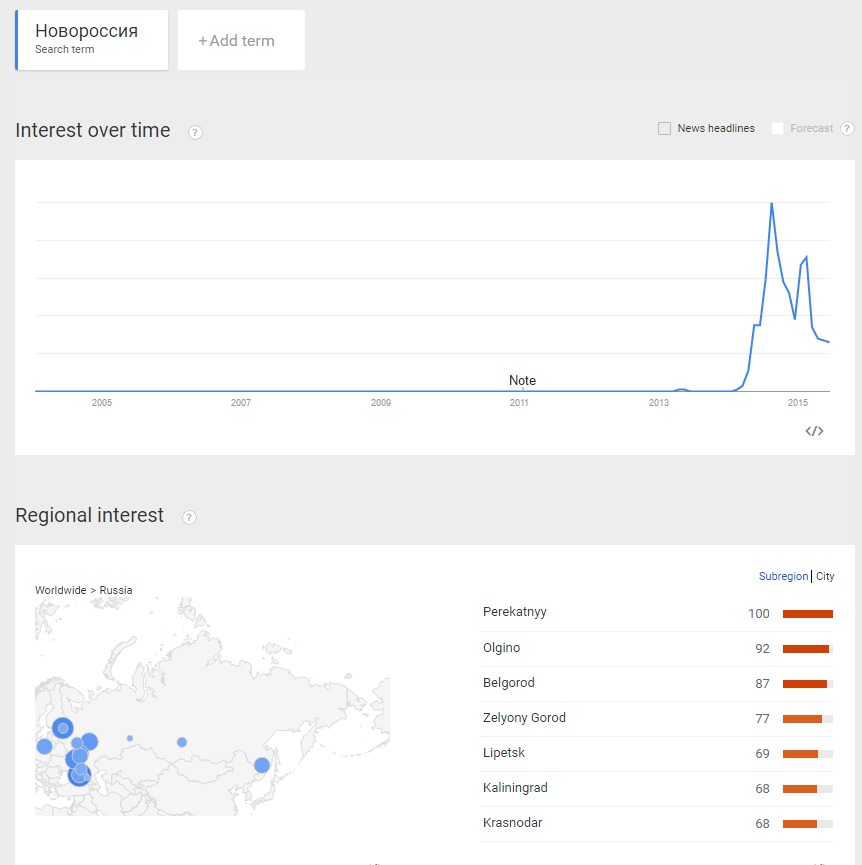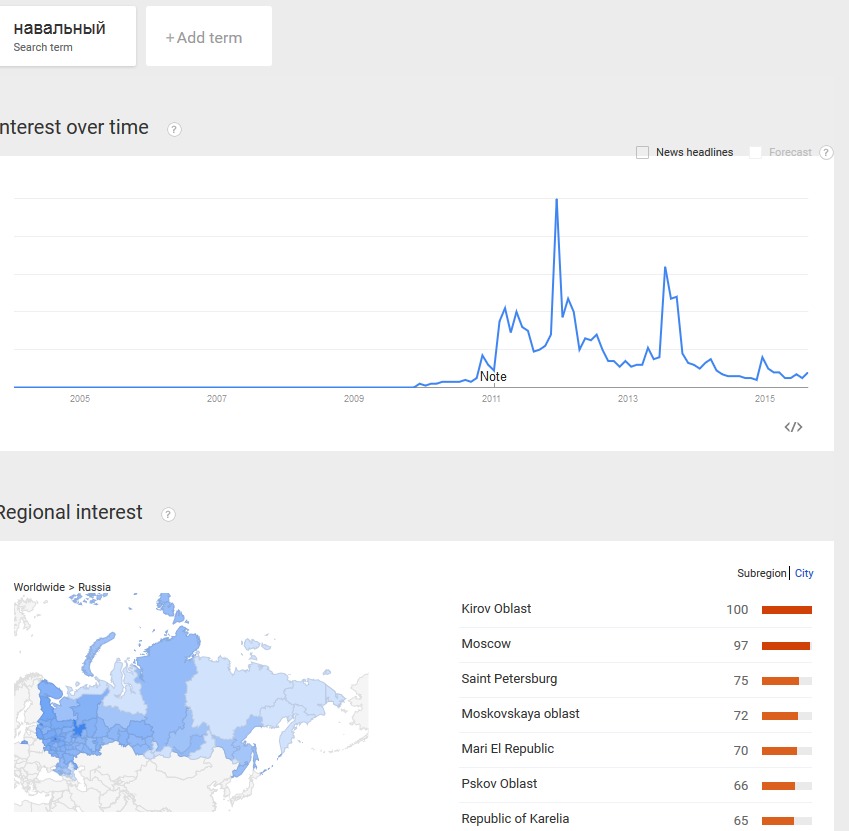Russian bloggers have discovered that by plugging search terms into the service Google Trends, apparently the location of some of Russia’s notorious “troll factories” can be discovered
Welcome to our column, Russia Update, where we will be closely following day-to-day developments in Russia, including the Russian government’s foreign and domestic policies.
The previous issue is here.
Special features:
– ‘I Was on Active Duty’: Interview with Captured GRU Officer Aleksandrov
– Meet The Russian Fighters Building A Base Between Mariupol And Donetsk
– ‘There Was No Buk in Our Field’
– With Cash and Conspiracy Theories, Russian Orthodox Philanthropist Malofeyev is Useful to the Kremlin
UPDATES BELOW
A Russian blogger has discovered that by plugging search terms into the service Google Trends, apparently the location of some of Russia’s notorious “troll factories” can be discovered.
Google Trends, released in 2006, shows the percentage of incidence of a search term matched to a geographic location.
Otakvot on LiveJournal came up with the revelation that abnormally high number of Google searches for terms like “Right Sector,” the militant ultranationalist group in Ukraine; or “Novorossiya,” the aspirational country to be formed out of parts of Ukraine, Moldova and Belarus; or “DNR,” the self-proclaimed “People’s Republic of Donetsk”; did not come from high population centers such as Moscow but turned up in Olgino, a St. Petersburg suburb.
The Interpreter has covered extensively the most notorious of the “troll factories,” the innocuously-named “Internet Research, Inc.” which moved from Olgino to 55 Savushkina Street in St. Petersburg earlier this year.
Other areas with the highest percentages of such searches were Perekatny, population 244, and Yablonovsky, population 30,518 —
both suburbs of the North Caucasus city of Krasnodar, capital of
Krasnodar Territory in southern Russia.
Otakvot noted that using Google Trends, it wasn’t surprising to find that a term like “tourism” in Russia turned up the highest frequency in Moscow and Ulan Ude, the capital of Buryat Mongolia, or “edible mushroom” was sought most often in Volgograd, one of the places where Russians have died eating poisonous fungi.
But when all the terms associated with the war with the war in Ukraine turn up in Perekatny, population 244, and Yablonovsky, population 30,518 — both small towns in the Adegei Republic but also suburbs just outside of the North Caucasus city of Krasnodar, capital of Krasnodar Territory in southern Russia, it’s certainly odd.
There doesn’t seem to be anything known publicly in this location
except for the Kuban State University, which isn’t known for research on
this subject. So the hypothesis is that there is some kind of government or pro-Kremlin installation here that is monitoring media and/or engaging in
propaganda.
It makes sense when we pull back from the map and see Krasnodar is
in a region of high strategic interest to Russia — near the Black Sea
port of Novorossisk and across from Mariupol in Ukraine to the north and
Kerch and Sevastopol in Russian-occupied Crimea to the west.
We tested the terms in Russian on Google Trends and got the exact
same results. As a control, we found if we typed in the Russian word for
“weather,” the searches tended to be in some of the coldest areas of
Russia, like the Nenets region where temperatures plunge to -50 Celsius,
but also curiously Krasnodar Krai and Adegei showed up, although the average temperatures there are mild compared to many other hotter or colder locations in the Russian Federation.
Otakvot isn’t the first to discover this “troll trends” phenomenon,
although he has got a lot of publicity in Russian social media this
week for his find; in April, a group of members of a Russian systems
administrators’ chat site also noted the strange correlation between the
search terms for the war in Ukraine and these locations.
One systems administrator found that there was an abnormally high
interest in the term “Obama” in Olgino and Perekatny, with Moscow, which
would presumably be more typically preoccupied with foreign affairs,
only in third place.
Searches for the name of an extremist Ukrainian parliamentarian
named Oleg Lyashko turned up the highest in Perekatny and Zelyony Gorod,
a suburb of Nizhny Novgorod where both Otakvot and the systems
administrators found a high incidence of the Ukrainian war terms and therefore believe there is a “troll factory” there.
term “DNR” — the acronym for the self-proclaimed “People’s Republic of Donetsk” shows up not at all in Moscow but first in Taganrog, a large
city near the Ukrainian border where Russian convoys on their way to
Ukraine have often been spotted, second in Perekatny again, then in
Kursk and Olgino.
state journalists writing on the topic — isn’t first for “Novorossiya,”
either, but Perekatny is; followed by Olgino and Belgorod — another
town where bloggers suspect there could be some sort of “troll farm.”
Zelyony Gorod is in fourth place.
Perhaps the trolls are more
active on terms associated with the Ukrainian war than with the Russian
domestic opposition.
“Alexey Navalny,” the name of the opposition leader who won 30%
of the vote in the Moscow mayoral election of 2013, the frequent target
of fabricated criminal cases in retaliation for his challenge to Putin,
shows up first in Kirov Region, second in Moscow, and third in St.
Petersburg. Why Kirov? This was the site of one of his criminal trials,
the Kirovoles lumber fraud case for which he is serving a suspended
sentence. This revelation from Google Trend suggests that when the
Kremlin persecutes opposition figures, it only invites more interest in
them.
Pro-Kremlin bloggers have responded to these exposes by
saying that they are anomalies or that the Kremlin trolls would cloak their Internet service
provider and wouldn’t be identifiable by location. But while such propaganda workers may hide their
ISP when trolling forums and media comment sections, they may not do so when at work
doing research.
The Russian bloggers seem to have made their
case — even the term “Ukraine” produces the highest hits in Belgorod
and Perekatny — and also Yablonovsky and Olgino.
More investigation will be needed to figure out what kind of
institution is performing these services and to what end. While the
hypothesis that these areas are the same kind of operations as Olgino,
they could just as likely be intelligence agency installations
monitoring media and communications for these terms. In that sense, it’s
too bad Google Trends doesn’t work in reverse – that hovering over a
geographical location reveals its most common searches and thus
intentions (although Google engineers can see this information.)
The “troll factories” are unlikely to disappear any time soon
although they may be driven further underground by these exposes.
Recently Ludmila Savchuk, a former employee of the office at 55
Savushkina who had gone undercover to work for Internet Research, Inc.,
sued her employer for a symbolic one ruble for unpaid wages and won her
suit, Deutsche Welle reported. Her main purpose was to prove that the operation existed, although her goal of getting it shut down was not met.
— Catherine A. Fitzpatrick
